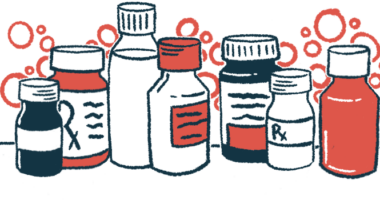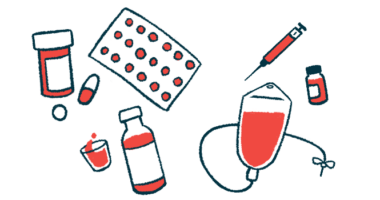Most Patients Adhere to Betaseron Therapy Over 1 Year, App Data Show

Multiple sclerosis (MS) patients treated with Betaseron (interferon beta-1b) had over 90% treatment compliance — the percentage of doses administered — over one year, according to a study of data collected by the BETACONNECT autoinjector and the myBETAapp.
After one year, the number of patients still using Betaseron dropped to 76%.
Researchers also demonstrated the feasibility of including remotely collected patient-reported outcomes in future studies.
The study, “Ascertaining Medication Use and Patient-Reported Outcomes via an App and Exploring Gamification in Patients With Multiple Sclerosis Treated With Interferon β-1b: Observational Study,” was published in the journal JMIR Formative Research.
Betaseron, a formulation of interferon beta-1b, is an injectable medication for adults with relapsing forms of multiple sclerosis. It is thought that interferon beta-1a modulates immune activity and reduces the mistaken immune attack on the nervous system that is characteristic of MS.
In Germany, many MS patients on Betaseron use the BETACONNECT autoinjector, which automatically records injections, alongside the myBETAapp, which allows patients to log injection data manually or by automatic transfer from the autoinjector.
The study (NCT03808142), conducted by researchers in Germany, investigated medication-taking behavior over a one-year period in people with MS treated with interferon beta-1b based on data collected from the app. It also collected additional information on patient-reported outcomes.
As cognitive impairment is common in MS, the team also studied the optional use of the cognitive training tool PEAK to test the feasibility of gamification — using game elements in non-game contexts — to incentivize patients to remain in the study.
Of 1,778 registered app accounts at the time of the study, 62 (3.49%) were eligible for the prospective (over time) analysis. Among these, 60 also had retrospective data from before the study. The mean age of the 62 participants was 43.2 years, and 41 (66%) were women.
In the prospective portion of the study, the persistence — the number of patients still using Betaseron — was 85% at six months, which dropped to 76% by one year. Persistence was higher in men than in women at both time points.
Based on injection data, the compliance — the percentage of expected doses actually injected — was high at six months (mean 93.6%) and at one year (mean 92.6%) and was similar among men and women. A total of 69% missed up to 5% of expected injections at six months and 56% at one year.
Adherence — the number of patients who were 80% or more persistent or compliant — was 90% in men and 66% in women at six months. Although there were no differences in adherence across all age groups at six months, it was lowest in the youngest age group at one year.
An analysis of retrospective data showed persistence was 83% at six months, 70% at one year, and highest in men than women at both time points. Mean and median compliance was high in both men and women at six months and one year.
In total, 73% of participants missed 0%–5% at six months and 62% after one year, with adherence higher in women than men at both times. Those 50 to 59 years old showed the lowest adherence at six months, while those younger than 30 had low adherence after one year.
The patient-reported EQ-5D-5L questionnaire, which assessed mobility, self-care, usual activities, pain/discomfort, and anxiety/depression, found women reported more severe difficulties with mobility, usual activities, and pain.
The treatment satisfaction questionnaire for medication scores remained stable during follow-up, with no difference between men and women, but were lower in the youngest age group. Median score for treatment effectiveness and side effects was consistent between the age and sex groups, while the median score for convenience was higher in men than in women and lowest in the youngest age group.
Most participants were “satisfied” or “neither satisfied nor dissatisfied” with the autoinjector, “satisfied” or “very satisfied” with the app, and “satisfied” or “neither satisfied nor dissatisfied” with the support offered by the BETAPLUS Patient Support and Disease Management Program.
In the pre-study (baseline) quality-of-life questionnaire, scores were higher in patients who were persistent and adherent than those who weren’t. Scores were also significantly associated with persistence and adherence at one year but not six months, according to statistical analysis.
Baseline treatment satisfaction scores for effectiveness, side effects, convenience, and overall satisfaction were higher in patients persistent and adherent compared to those who were not.
The proportion of patients who were “satisfied” or “very satisfied” at baseline with the autoinjector and the app was higher in persistent and adherent patients.
Finally, with PEAK, in which participants were able to choose from all available games covering seven cognitive areas, a higher proportion of men (67%) than women (49%) used the games at least once, and the lowest usage was among those 60 years and older.
The 10 most popular games included four in the language category (Babble Bots, Word Hunt, Word Fresh, and Grow), two in the focus category (Objectifind and Must Sort), two involving problem-solving (Pixel Logic and Low Pop), one testing memory (Perilous Path), and one involving mental agility (Turtle Traffic). Pixel Logic was played for the longest cumulative time over the year.
“This study showed high compliance and decreasing persistence and adherence over 1 year and demonstrated the feasibility of including remotely completed electronic [patient-reported outcomes] instruments in digital observational studies,” the team concluded. However, “the feasibility and influence of gamification in this setting remain unclear.”








